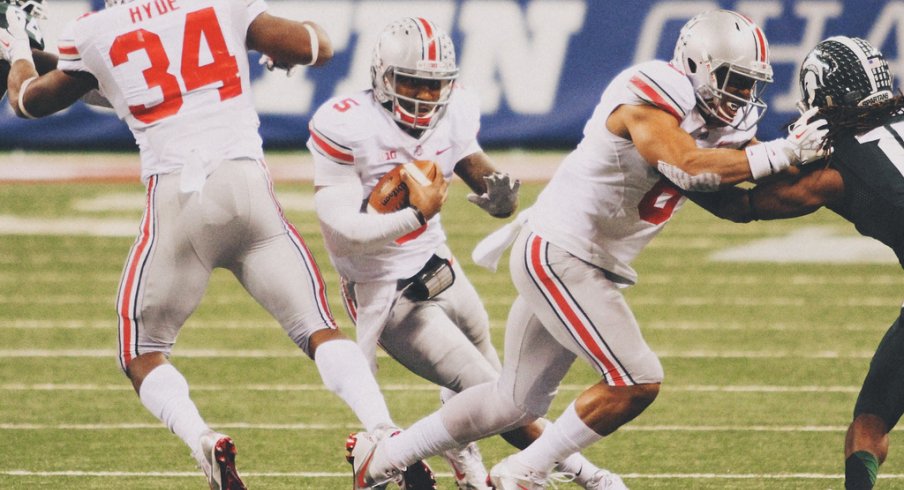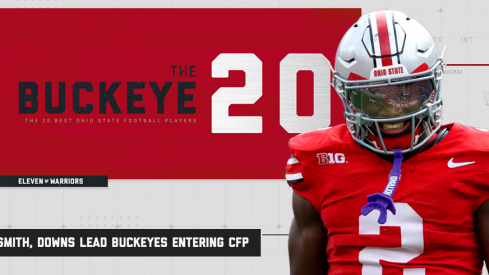The days of "three yards and a cloud of dust" are long gone in Columbus.
With the hiring of Urban Meyer at Ohio State in 2012 came the 'spread-to-run' offensive philosophy that became his calling card in previous stops at Bowling Green, Utah, and most recently, the University of Florida. With the additions of offensive coordinator Tom Herman from Iowa State and offensive line coach Ed Warinner (both considered to be rising stars in the profession), Meyer not only diversified the playbook, but changed the culture on the offensive side of the ball.
After amassing 7,167 yards of total offense and averaging 45.5 points per game in 2013, the Buckeyes not only set school records, but re-defined what success looks like on the offensive side of the ball.
With Braxton Miller returning and looking to add to his two Big Ten Offensive Player of the Year awards, the Ohio State offense remains the gold standard in the Big Ten after leading the conference in nearly every offensive measure. Even with the loss of star running back Carlos Hyde and four starters on the offensive line, the scarlet and gray seem poised to continue their dominance on this side of the ball.
For opposing coaches, the task of stopping the Buckeyes remains a unenvious one. But while the OSU offense may not resemble the traditional offenses of the past, the Buckeyes actually run a fairly simple scheme. With an emphasis on keeping opponents off balance through both alignment and pace, the Buckeyes are often able to simply out-execute their opponents, running the same plays over and over to perfection.
So what do opponents see when looking to stop the Buckeyes? Let's take a look.
Personnel
The Buckeyes almost exclusively line up in "11" personnel, meaning they have 1 running back and 1 tight end on the field, which (along with five offensive linemen and one quarterback) means there are three wide receivers on the field.
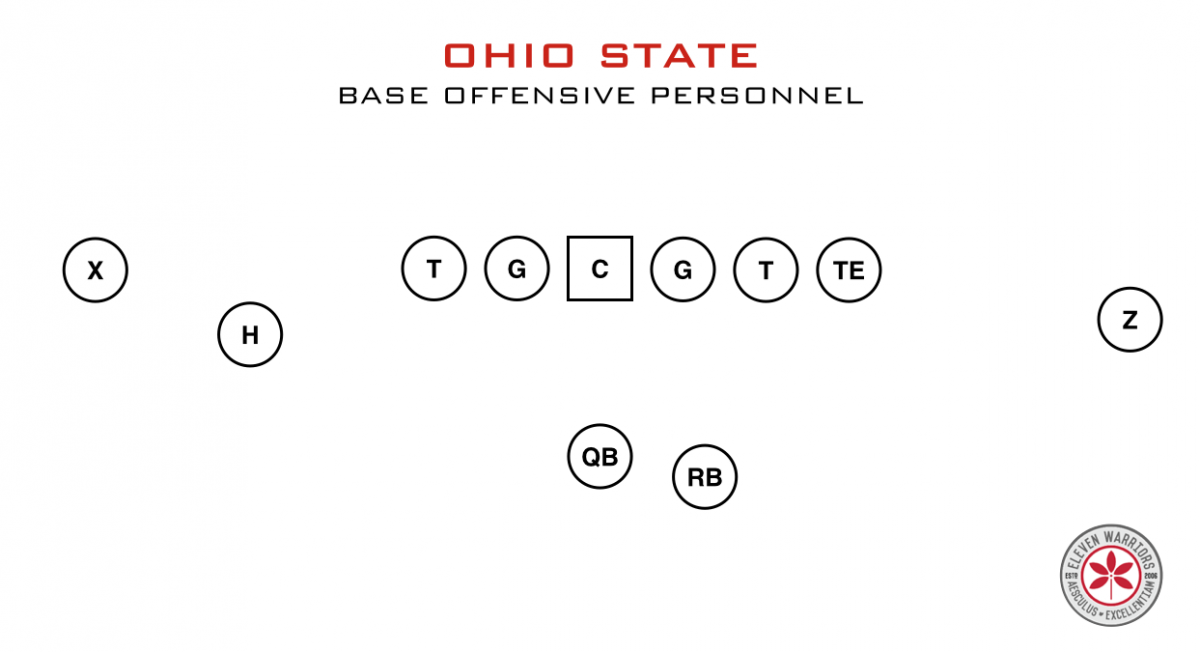
While they appear to line up in a traditional "spread" offense personnel group, the Buckeye offense under Meyer has consistently looked for specific traits from each skill position:
- Quarterback: Often asked to make quick decisions, must be athletic enough to pose a threat to run
- Running Back: Downhill runner that spends the majority of time in between the tackles, must be strong enough to run through arm tackles, quick burst valued more than top end speed
- Tight End: Jack of all trades that lines up all over the field, must block like a traditional fullback, also asked to contribute in downfield passing game
- X Receiver: Very involved in screen passes as a blocker and receiver, often the least explosive of the three receivers
- Z Receiver: Runs vertical routes and acts as deep threat most often, must also contribute as a blocker in the running game
- H Receiver: Wildcard of the offense, involved equally as both runner on outside handoffs and options and receiver in short screens and option routes
As the diagram shows above, the three wide receivers are denoted as H, X, and Z. While the X and Z receivers are what would often be considered "traditional" wide receivers, running vertical pass routes and blocking on running plays, the H receiver is the wildcard of the Buckeyes offense.
Though the H position was often manned by Corey 'Philly' Brown over the past two years, the Buckeyes are expecting big things from sophomore Dontre Wilson. By motioning Wilson in and out of the backfield, the Ohio State offense will attempt to get him the ball in situations where he can be exploit his greatest talent: speed.

By consistently using this three-receiver set, the Buckeyes are able to spread out their opponents horizontally, forcing them to defend from sideline to sideline. More than often than not, opponents are forced to remove a linebacker or linemen and play with an extra defensive back to keep up with the extra speed the Buckeyes present. In turn, the Buckeyes gain an advantage when running between the tackles in this situation, as a typical run-first defender has been removed from the equation.
Teams with NFL-caliber athletes at linebacker, such as Michigan State, have been able to keep their base defense on the field with the Buckeyes in the past. But the constant threat of explosiveness in the form of Wilson makes that scenario even more challenging. To match the athleticism of the Buckeyes, it's very likely that nearly every defense the Buckeyes face this fall will take the field in that five-DB look.
Running Game
Without question, the foundation of the Ohio State offense under Meyer, Herman, and Warinner has been the Tight Zone. This fairly simple concept is installed on day one of spring and fall practice, and acts as the starting point for nearly everything else the Buckeyes try to do when they have the ball.
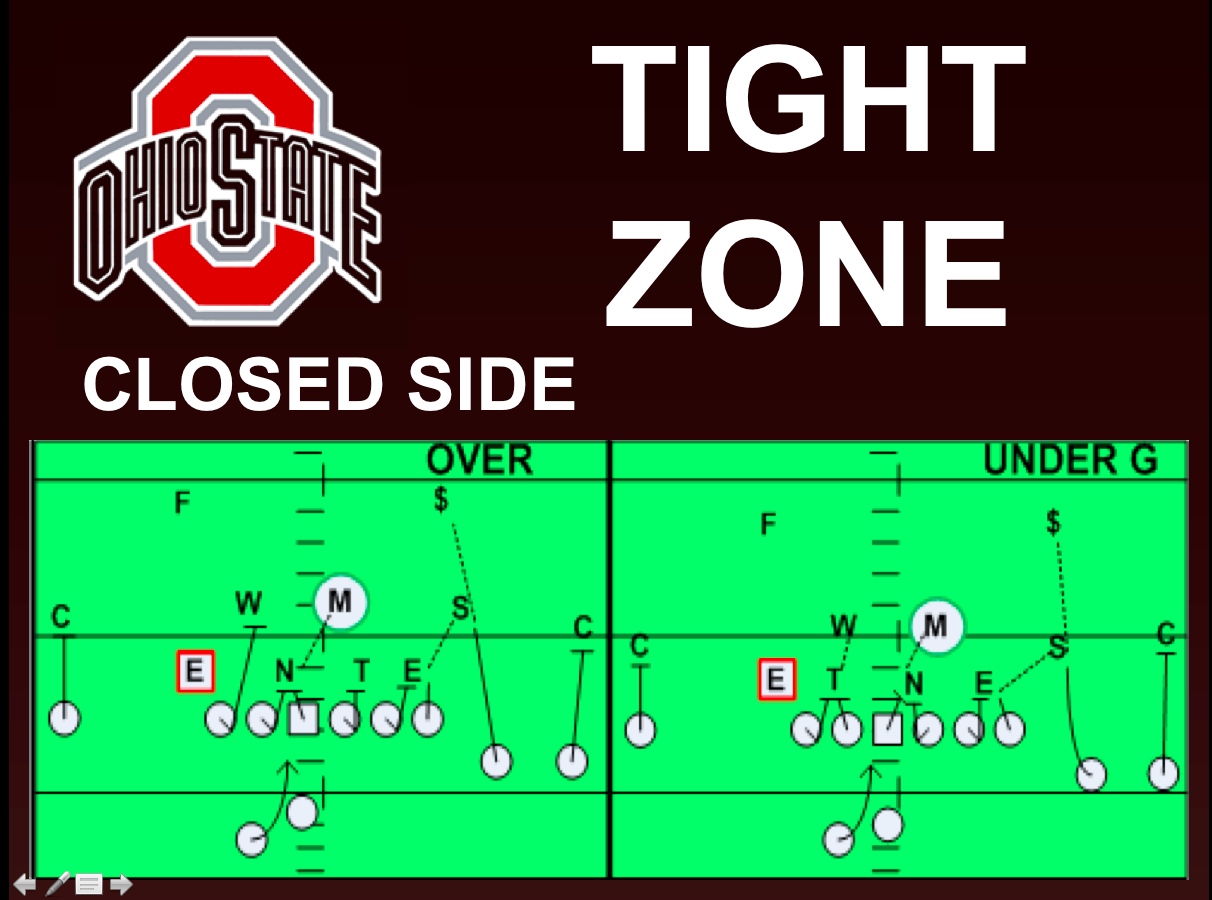
But while the concept may be both literally and figuratively straightforward, the Buckeyes have mastered the techniques necessary to execute this play against nearly any defensive front. Since the offensive line is governed by a set of rules on the play, and not assigned to any particular defender, they're able to adjust on the fly.
Knowing they can execute the play at virtually any time, the Buckeyes are able to control the tempo of the game, often lining up quickly for the next play without a huddle to keep the defense off balance. Even if their opponents are able to change what they're doing to defend, the Buckeyes have often seen that adjustment before, and know how to handle it with ease.
This fairly simple play allows OSU to keep the defense off balance in other ways as well. In particular, the defensive end with the red box around him in the diagram above doesn't get blocked on the play. Instead, he will be read by the QB and virtually taken out of the play that way. If the end crashes down to try and tackle the running back, Miller will simply fake the handoff and run outside, as we've seen him do countless times over the past two seasons.
While the Buckeyes also run the "Power" and "outside zone" on occasion, the tight zone accounted for the vast majority of Carlos Hyde's carries in 2013, which resulted in over 1,500 rushing yards for him alone. There's no reason to think the Buckeyes will change this approach in 2014, even though a new starter at running back is yet to be named.
But the Buckeye running game doesn't stop there. With such a great weapon at hand in Braxton Miller, the OSU coaches regularly call a number of plays that highlight his unique ability to run the ball. Since the offensive line already has the scheme in place to block the "Power" play, the Buckeyes will often run the "inverted veer" made famous by Gus Malzahn's offense at Auburn. On this play, Miller now options the front side defensive end with the option of handing off to the running back on an outside sweep, or running inside behind his pulling guard in what effectively becomes a regular "Power" play.
Additionally, Meyer and the coaches will regularly call runs designed directly for Miller, in the form of sweeps and counters.
With so many proven ways to beat a defense on the ground, the Ohio State running game has proven incredibly difficult to stop. However, as Clemson showed in the Orange Bowl, the task is not impossible. The Tigers held the Buckeyes to 193 yards rushing, and a season-low average of 4.02 yards per carry. Specifically, the Tigers shut down Miller, only allowing him 35 yards rushing on 18 carries, by far his lowest output of the season.
It's likely that the Tigers provided a template of how to shut down Miller, although much of that credit belongs to the athleticism of Vic Beasley and the Clemson defensive line.
Very often, defenders will wait for Miller to make a decision to hand off or keep, but Beasley forces Miller into an uncomfortable spot where the timing of the handoff is rushed. In addition, the other Clemson defensive linemen don't allow themselves to be double-teamed by the Buckeyes, instead bull rushing straight ahead at both guards and forcing penetration into the backfield. Had Miller made the handoff to Hyde, he wouldn't have had anywhere to go.
Teams with great athletes like Virginia Tech, Michigan, and certainly Michigan State will all likely try to copy this blueprint this fall, hoping their defenders up front are able to win enough of these individual battles to upset the cadence of the OSU running game. For teams with lesser athletes though, the challenge is much more difficult. Such opponents are forced to commit extra defenders into the box, hoping to overwhelm the Buckeye blockers, but leaving their pass defense exposed in the process.
Passing Game
When teams decide to commit extra defenders, often defensive backs, inside to defend the run, the Ohio State offense tries to expose their newfound numerical advantage outside. Most often, the Buckeyes like to package their tight zone running play with a quick pass to the outside. The offensive line and running back will run the tight zone, but instead of reading a defensive end and potentially keeping the ball to run, Miller now has the option to throw a quick pass outside to one of his receivers.
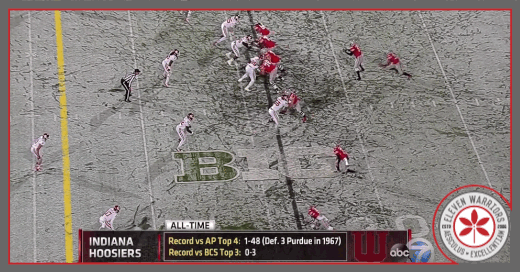
The quick pass might be a wide receiver screen, like we see below to the H receiver, or it might be a quick hitch to the Z on the opposite side.

With the constant threat of the tight zone, the Buckeyes found these short, quick passes open quite often, and Meyer has even said that we'll likely see more of this in 2014.
Meyer: "We'll probably rely on quick passing game more than we have ... last yr we got comfy with that big back and that OL."
— Patrick Maks (@maksimuspatrick) August 10, 2014
To build on the threat of the running game, the Buckeyes like to often throw deep on play-action as well. Not only do the Buckeyes have deep play-action passes built off the tight zone, but nearly every other base run play described above as well. As we can see below, it's critical for the offensive line and running back to sell the fake just as much as the quarterback. The entire Wisconsin defensive line is going one way, allowing Miller the room to set up and make a great throw.
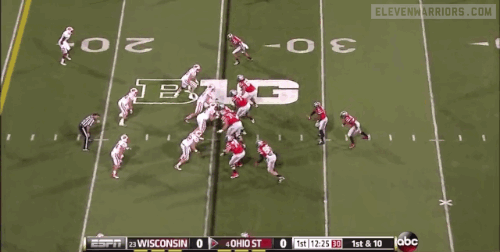
The Buckeyes have found the most success throwing the deep ball on early downs, when the threat of the run is most apparent. But they haven't found as much success in the past when trying to convert longer passing situations.
In these scenarios, the Buckeyes usually attack defenses in one of two ways. The first, and most basic, concept is by running variations of the four verticals attack.
What might look like a "everyone go long" play you ran in your backyard is actually all about timing and matchups. With the threat of Miller to run on any broken down passing play, defenses often like to play a zone defense, allowing their players to keep an eye on the backfield and help out if Miller takes off.
But by playing a zone, a defense is effectively showing the Buckeyes where the holes will be, allowing the receivers to slightly adjust their routes and Miller to throw to a spot, which in the example above was the open area between the two safeties, and just behind the linebackers.
In addition to vertical routes, the Buckeyes like to run "flood" routes that might overwhelm one of these zones to either side. By putting more receivers to one side of the field than there are defenders to cover them, the Buckeyes theoretically have the chance to always make the defense wrong.
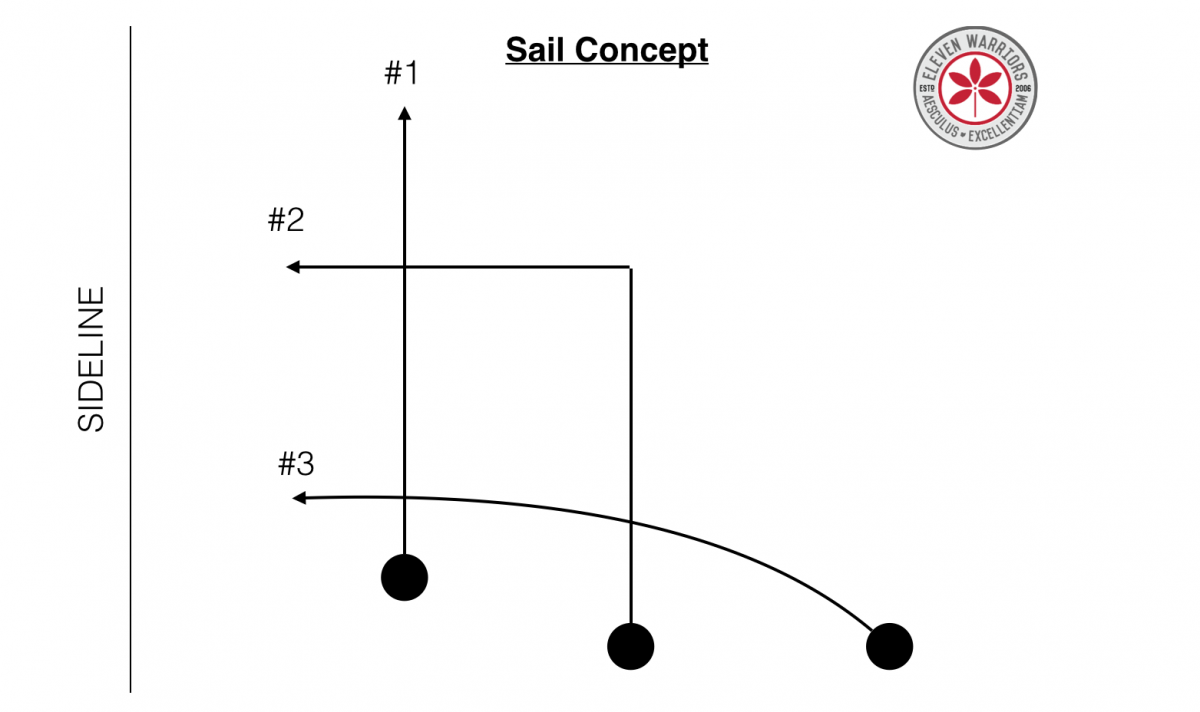
To make thing even easier for the quarterback, the Buckeyes often won't even run routes to the opposite side of the field, allowing him to make an easy read from deepest to shortest.
While these concepts are great in theory, they've proven more difficult to execute against press defenses. As Michigan State has shown the past two seasons, Buckeye receivers have struggled to get off the line of scrimmage when they're jammed by opposing defensive backs. Additionally, OSU wideouts have had problems creating the separation needed to get open when facing man-to-man coverage, something Meyer eluded to recently at Big Ten media days.
Urban: "I'll be disappointed if the receivers aren't able to carry their own weight."
— Patrick Maks (@maksimuspatrick) July 28, 2014
There's no question that development in the receiving corps offers the biggest question mark in defending the Buckeyes. If they're able to beat press-man coverage, the potential of the Buckeye offense remains endless. While throwing off their timing isn't going to stop the offense completely, it begins to undermine the entire effect of the offense overall. If they can't get off the line, then the defense can commit more defenders to the run.
There's no doubt that defensive coordinators like Bud Foster, Pat Narduzzi, and Greg Mattison will force Wilson, Devin Smith, Evan Spencer, and a slew of young Buckeye receivers to show them they're capable of beating the press. It might be their only chance of slowing down Meyer, Miller, and the rest of the Buckeyes in 2014.
